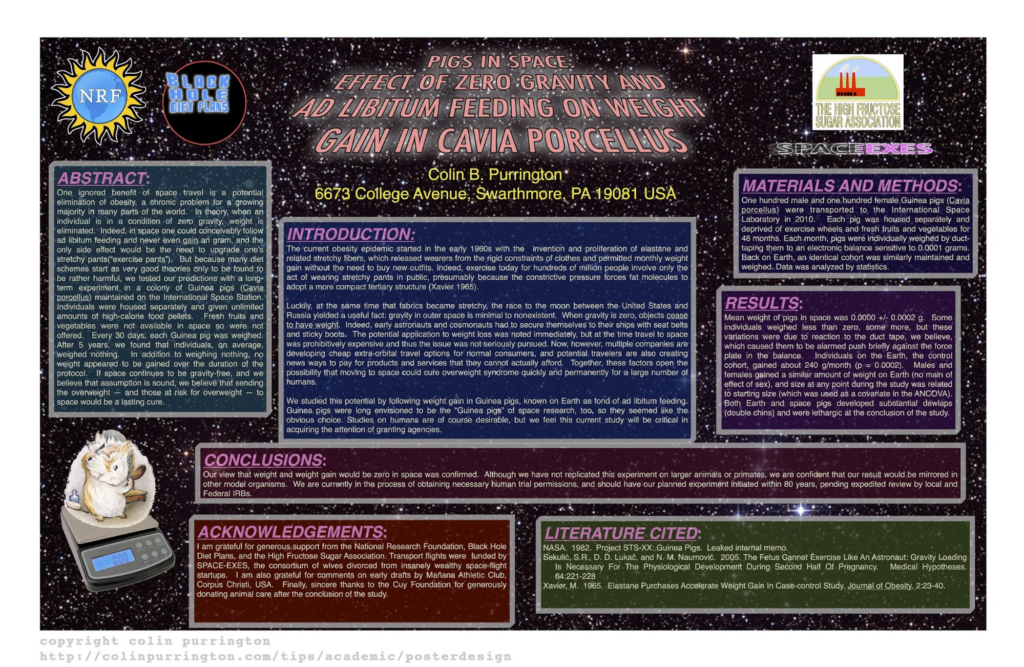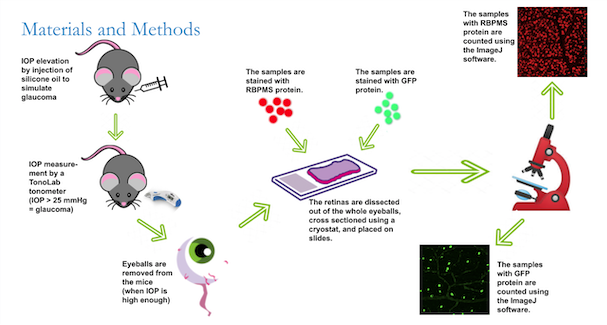
After completing your research internship, you may be interested in taking your learning one step further by creating a research poster and possibly submitting your work to a science fair competition. However, from personal experience as well as what I’ve seen from other high schoolers, I have realized that starting to create a research poster can be an extremely intimidating task. Don’t worry! I have the tips and tricks to help.
First of all, let’s go over the basics: what is a research poster?
Research posters are widely used in the academic community to summarize information or research concisely and attractively to help publicize it and generate discussion. Posters are usually a mixture of short paragraphs of text interspersed with tables, graphs, pictures, and other presentation formats. Nearly all research posters are organized into sections. Common sections include an abstract, introduction, methods, results, discussion, and acknowledgments. Any more sections than these 6 is too many sections — you probably will not even have enough space on your poster for any more sections.
Typically at science fairs or conferences, researchers stand by their posters and explain their research to others. Keep in mind that a research poster is meant to be a very condensed version of your research paper; it should not be text heavy at all as that will very quickly discourage others from taking interest in your research.
What makes a good research poster?
- Important information should be readable from about 5-7 feet away.
- The title should be clear, concise, and draw people’s attention to your research.
- Paragraphs of text should not be overly long. Bullet points, numbering, short statements, and headings to break up text are crucial.
- Effective use of graphics and color will catch your reader’s attention immediately.
- Consistent and clean formatting and layout.
- Includes acknowledgements (such as the lab you worked in, the PI of the lab, and your mentor), your name, and institution affiliation (ie the university that allowed you to perform research).
Here is an example of a well designed research poster:

Here is an example of a poorly designed poster:

Now, that you know the basics of what a poster is as well as features of a good poster, let’s get into how to actually create a research poster:
- Identify which software to use to create your poster design. If you would like to create your research poster’s design from scratch, there are several different softwares that you can use: Powerpoint, Google Slides, Adobe Photoshop, Adobe Illustrator, and Adobe Indesign are a few good options. I would recommend using Google Slides or Powerpoint since those two are the simplest softwares, especially if you do not have prior experience using the other Adobe softwares. Also, consider using research poster templates that you can find online. These templates are already designed so all you have to do is customize them. This way you don’t have to do all the designing work from scratch. Finally, look into specific research poster templates that your lab typically uses. Many universities have pre-designed templates that they strictly require their labs to use. Ask your mentor and do Google Searches to find these templates. For example, I did my research at UCSF, and I asked my mentor for a research poster template from UCSF, which greatly reduced my work since I just used UCSF’s pre-designed poster templates.
- Think about what it is you want your poster to convey about your research project. Answer the following questions to determine what your research poster will be about: What results did I collect at the end of my project? What was the goal of my project? What is the most astounding/interesting/unique finding from my project? Once you answer these questions, you have identified the goal and overarching subject of your research poster.
- Do research about topics related to your research project’s focus. To accurately write and portray many facts about your research project, it is crucial to do research about your project’s focus as well as surrounding topics. This is important because you want to be fully informed before you start working on your poster. Additionally, many of the scientific papers and journals you find many actually help you write your poster.
- Start writing. It’s time to dive right in. But, for now, forget about your research poster template entirely. Create a fresh Google Document, or Word Document, and start writing there first. It can be much easier to edit, review, and make changes to the writing portion of your poster if you are doing the work in a Google Doc first.
-
Tackle individual sections, instead of the entire poster. Like I talked about earlier, there are several different sections of a research poster. However, working on them all at once can be quite an intimidating task. My advice is to start slow and work on one section at a time.
- Write your introduction first: talk about the background of your topic and introduce the novel ways your topic contributes to the field.
- Next, write your methods: walk through each step of your research project, clearly identifying the different processes used.
- Then, formulate the results: results can be presented in several different ways, including graphs, charts, data tables, figures, or a combination of multiple; figure out what works best for your project and create the results accordingly.
- Next, write the discussion: explain your results and the implication of your results; also, discuss the broader significance of your findings; consider how and what your research projects contributes to the field you studied.
- Then, write the abstract: because the abstract is a short, concise summary of your entire project, it is helpful to write it last when you have completed all the other sections; this way you know exactly what to mention in the abstract.
- Finally, complete your acknowledgements: this is the shortest section but a very powerful and important one; make sure you thank your lab, your PI and mentor, and the university for their assistance, graciousness, and mentorship throughout your research project.
- Find someone to review and edit your writing. Getting a second set of eyes to read your writing can be extremely helpful, especially if the person has experience with or a background in your topic as well as writing research posters. This person can point out important things in your poster, anything from simple grammatical errors to entire restructuring of certain sections.
- Create your graphics. Identify how you want to bring color and graphics into your poster. One common way of doing so is to make your methods section a series of graphics, rather than writing out your methods section in bullet points. For example:

- Assemble all your work onto your research poster. Now that you are done writing the sections of your poster and creating your graphics, it is time to bring everything onto your research poster. It is likely that the sections you wrote are lengthier than what you should include on a research poster, so consider cutting your sections or formatting them through numbering, bullet points, and subheadings. Make sure to properly format your research poster: little things such as the alignment of certain sections as well as a constant color scheme can make quite a difference on the success of your overall poster.
- Ask that someone to review your poster one final time. Call upon the person who reviewed your poster previously to help you once more. Ask them to read through your entire research poster and give you their genuine feedback so that you can make some final changes.
- Submit your poster to science fairs and competitions. You are just about done with your research poster! If you wish, you can now submit your poster to science fairs and competitions. Many science fairs and competitions have their own rules such as they require your poster to be certain dimensions, have specific sections, and be formatted in certain ways. However, science fairs, if you do well, can be extremely great learning opportunities as you come in contact with the research of hundreds of students. Also, winning or placing at a science fair can be an absolutely stellar addition to your resume as well as college applications.
Throughout the process of creating a research paper, be patient with yourself. Without a doubt, this is an immensely time-consuming, tedious task. It is perfectly normal to experience a few bumps in the road and get frustrated from time to time. Keep in mind that this is probably the very first time you are doing something like this, so it is bound to be imperfect. However, you will learn immensely throughout the process, and I promise that the next time you create a research poster, it will go much more smoothly.